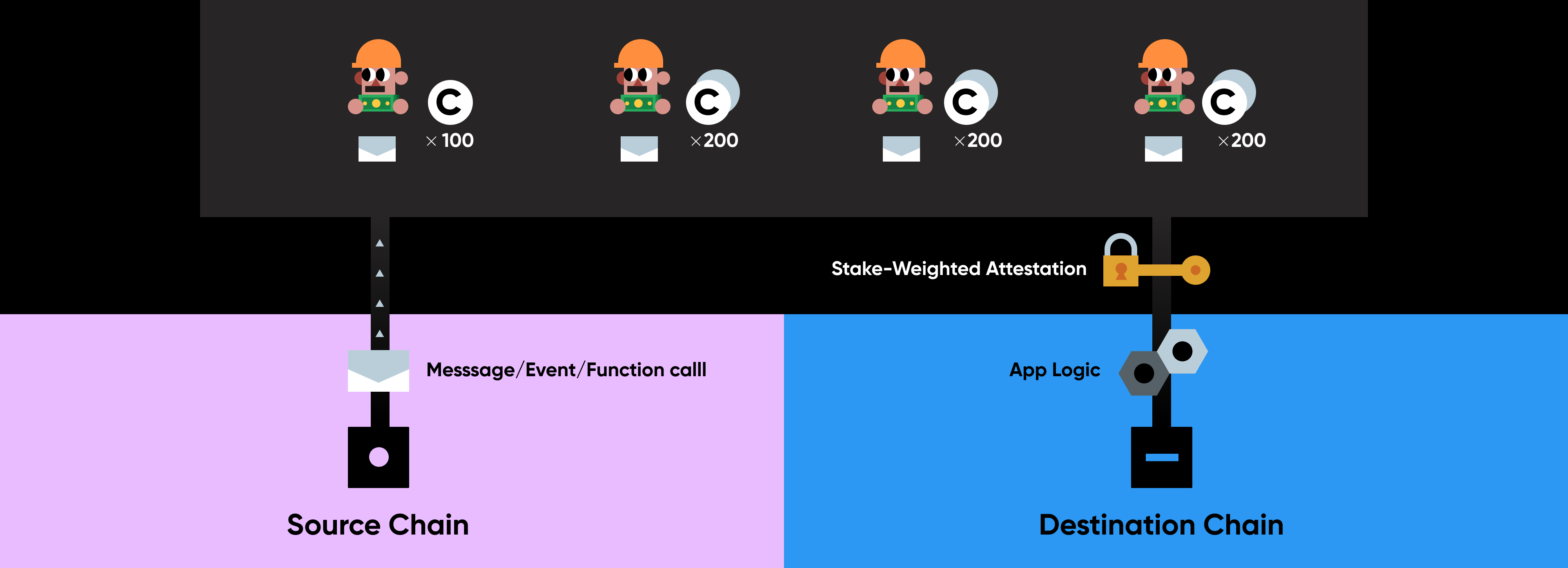A
Multi-blockchain
Operating
System
Multi-blockchain
Operating
System
PoS and Optimistic-rollup-like Security Models
Inter-chain dApps built on top of Celer can choose two different security models with different tradeoffs on delay.
By default, inter-chain dApps rely on the security of the State Guardian Network by processing messages routed from another chain without delay. The SGN offers L1-blockchain level security just like Cosmos or Polygon with it being a Proof-of-Stake (PoS) blockchain built on Tendermint with CELR as the staking asset. If a guardian acts maliciously, its staked CELR will be slashed by the consensus protocol. This level of economic security is something that grows with the staked CELR’s value and is simply not available in simple Multi-signature or MPC-based solutions.
Even under the extreme case of 100% of the guardians behaving maliciously, inter-chain dApps can maintain full security with an optimistic-style delay buffer. Instead of instantly processing a message routed by the SGN, an inter-chain dApp can inject a mandatory delay buffer and run an independent watchtower service to double-validate the message on the source chain. If the watchtower service detects any inconsistency, it can prevent the message being processed before the delay expires.
By default, inter-chain dApps rely on the security of the State Guardian Network by processing messages routed from another chain without delay. The SGN offers L1-blockchain level security just like Cosmos or Polygon with it being a Proof-of-Stake (PoS) blockchain built on Tendermint with CELR as the staking asset. If a guardian acts maliciously, its staked CELR will be slashed by the consensus protocol. This level of economic security is something that grows with the staked CELR’s value and is simply not available in simple Multi-signature or MPC-based solutions.
Even under the extreme case of 100% of the guardians behaving maliciously, inter-chain dApps can maintain full security with an optimistic-style delay buffer. Instead of instantly processing a message routed by the SGN, an inter-chain dApp can inject a mandatory delay buffer and run an independent watchtower service to double-validate the message on the source chain. If the watchtower service detects any inconsistency, it can prevent the message being processed before the delay expires.

CELR Token Utilities and Value Capture
The CELR token is the protocol token for Celer Network. CELR is used as a staking token in the SGN to ensure the economic security of Celer IM. Stake your CELR here.
To use the SGN’s message routing service and to store the multi-signature attestation, users must pay a fee to the SGN for these services. This is like the fee being paid to any other PoS blockchain’s validators and the associated stake delegators. These fees are distributed to the CELR stakers and validators for their work in securing the network.
In addition to these fees, the SGN, as a tendermint blockchain, also issues block rewards for validators that produce the block. CELR tokens have to be staked in the SGN in order to receive these rewards. By staking, validators and stakers are actively participating in the operation of the protocol and under-taking the risk of slashing: if a validator is malfunctioning or is compromised to act maliciously, part of or all tokens delegated to this validator can be slashed according to slashing rules. Unstaked CELR tokens receive no rewards of any kind.
In addition, Celer Network also has a variety of operation parameters such as supported chains, fees level for each chain, supported tokens for asset bridging, and new modules that will be added. These parameters and the network upgrade process are all governed through the on-chain governance process of the SGN chain just like Cosmos or Polygon.
To use the SGN’s message routing service and to store the multi-signature attestation, users must pay a fee to the SGN for these services. This is like the fee being paid to any other PoS blockchain’s validators and the associated stake delegators. These fees are distributed to the CELR stakers and validators for their work in securing the network.
In addition to these fees, the SGN, as a tendermint blockchain, also issues block rewards for validators that produce the block. CELR tokens have to be staked in the SGN in order to receive these rewards. By staking, validators and stakers are actively participating in the operation of the protocol and under-taking the risk of slashing: if a validator is malfunctioning or is compromised to act maliciously, part of or all tokens delegated to this validator can be slashed according to slashing rules. Unstaked CELR tokens receive no rewards of any kind.
In addition, Celer Network also has a variety of operation parameters such as supported chains, fees level for each chain, supported tokens for asset bridging, and new modules that will be added. These parameters and the network upgrade process are all governed through the on-chain governance process of the SGN chain just like Cosmos or Polygon.

